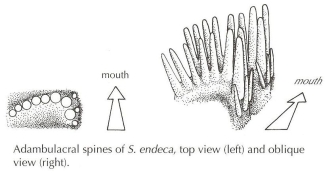Solaster endeca has a broad disc and 7 to 13 - usually 9 to 11 - short, sharply tapering arms. It is usually red or orange aborally and yellow or beige on oral side, but it occasionally has a purple stripe down each arm, similar to S. stimpsoni. The arm length can be up to 20 cm; the average length in British Columbia is 9 cm. The ratio of arm to disc is from 2.3 to 3.3. S. endeca has numerous fine, crowded aboral pseudopaxillae and 5 to 9 spinelets with single papulae between. Its disc is thick and tapers down to the arm tips. The superomarginals are only slightly larger than the aboral pseudopaxillae, but the wide inferomarginals alternate with them and form a very obvious series. The size of oral interradial area varies with the number of arms but is larger than the other species of Solaster. The adambulacral spines do not protrude noticeably above the general oral surface. There are 1 to 4 furrow spines deep in the furrow and a curved transverse series of 6 to 8 sharp spines on the oral surface. The inner and outermost spines of the curve are farthest from the mouth. The mouth plates have 7 to 9 marginal spines (the apical spines are largest) and 6 to 15 sub orals in two series or in a triangular group.
Characteristics
Similar SpeciesSolaster endeca differs from S. stimpsoni in its arm-to-disc ratio and the arrangement of the adambulacral spines.
